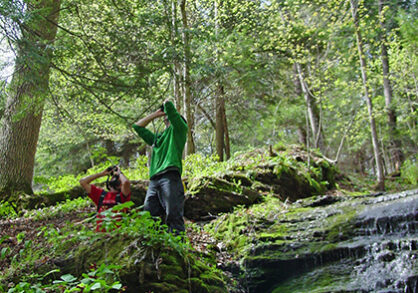Background
Native to Japan, the hemlock woolly adelgid (Adelges tsugae) is an aggressive insect pest that feeds on the sap of hemlock twigs. Eventually needles yellow and drop, branches die, and trees die in four to ten years. The insect poses a serious threat to both Carolina hemlock (Tsuga caroliniana) and eastern hemlocks (Tsuga canadensis), causing nearly 100% mortality in infested trees. The pest has decimated hemlock populations from North Carolina to eastern Pennsylvania and southern New England, and increasingly now around the Finger Lakes.
Eastern hemlocks are an important part of the forest ecosystems found in Finger Lakes region, and their disappearance causes negative environmental changes for many plants and animals. Hemlocks provide shelter for ruffed grouse, deer, and a variety of small mammals and birds. Their shade provides temperature regulation for cold-water loving amphibians, fish, and invertebrates. Growing in association with hemlocks, relict plants (species which require cool and moist climates found further north) are also threatened.
HWA at Cornell Botanic Gardens
Since 2009, when the insect was first found on eastern hemlock trees in Cascadilla Gorge, Cornell Botanic Gardens has been responding to the adelgid in our natural areas. Our holdings contain over 700 acres of hemlock-dominated forests, making control treatment for all sites and all trees unrealistic. Therefore, we developed a process to evaluate the conservation and educational value of the hemlock stands to guide our detection and control efforts.
Hemlock woolly adelgid (HWA) has now been detected in 16 natural areas through annual surveys administered with the help of many dedicated volunteers. The best strategy for managing HWA is to find it early and respond quickly with targeted, individual tree chemical treatments, which are effective for 5-7 years. To date, our Natural Areas Stewards have treated over 2,000 trees.
New York State Hemlock Initiative
New York State has committed funding to educate the public about HWA and for research into the development of biological controls (predatory bugs) that would provide a long term solution to the threat. In 2017, this support was used to create the New York State Hemlock Initiative, based at Cornell, to advance research and education to combat HWA.
Cornell Botanic Gardens works with the NYS Hemlock Initiative by hosting test plots of hemlocks for establishment, rearing food for potential predators of HWA, and caring for 40 introduced hemlock trees, which are potentially adelgid-resistant. The Initiative is led by Cornell Extension Associate Mark Whitmore who, along with other researchers, is attempting to discern if the apparent resistance to HWA is due to a unique hemlock adaptation or unique conditions present in the trees’ original location of New Jersey. Our natural areas are used to continue research to test optimal pesticide retreatment timing efficacy.
Also in partnership with the Hemlock Initiative, we conducted several inoculative releases of predatory biocontol agents. This included the release of 1,050 silver fly (Lecotaraxis piniperda) in the Lick Brook Natural Area in the spring of 2020; the release of a predatory beetle, Laricobius nigrinis and the silver fly in the fall of 2022 and spring of 2023 respectively, in the Fall Creek Valley Natural Area; a release of L. nigrinis at Coy Glen Natural Area in 2021; and a 2024 release of 2000 silver flies in the Fischer Old-growth Forest Natural Area to help conserve the oldest remaining hemlock stand in Tompkins County.
By providing an integrated pesticide treatment and biocontrol strategy, the effort should allow biocontrol populations to develop with healthy hemlock trees to remain, both spatially and temporally, aiding in the long-term success for biocontrol predators to build up in the environment and provide a long-term conservation solution for our hemlock forests.
Ongoing Efforts
In 2017, Cornell Botanic Gardens was awarded a New York State Department of Environmental Conservation Invasive Species Control Rapid Response Grant to administer a second treatment on many hemlock trees in our natural areas, treat newly infested trees, and collaborate with the NYS Hemlock Initiative to study the effectiveness of using biocontrol agents. Read more in this Cornell Chronicle article.
Future Forests
In response to climate change, forest pests like hemlock wooly adelgid, and invasive species that are negatively impacting the biodiversity of the landscapes we steward and cultivate, we established the Future Forests Initiative. We are raising funds to plant a variety of native trees and shrubs across our natural areas, cultivated gardens, and arboretum to increase their health and resilience.
Have questions? Visit our Frequently Asked Questions page, or Contact the Tompkins County Cooperative Extension at (607) 272-2292.
What can you do?
Report Sightings
Report hemlock woolly adelgid sightings.
Let us know
Contact our Natural Areas director to report heavily HWA-infested hemlock stands that appear healthy and potentially genetically resistant to HWA.
Volunteer Monitoring
Help report hemlock woolly adelgid infestations.
Join our E-list Serv
Join the hemlock woolly adelgid e-list serv
Learn more about HWA
Hemlock woolly adelgid’s biology, identification, and control.




